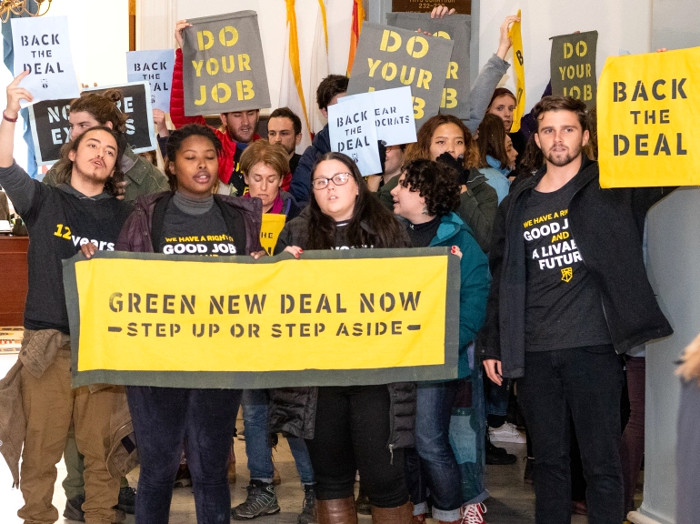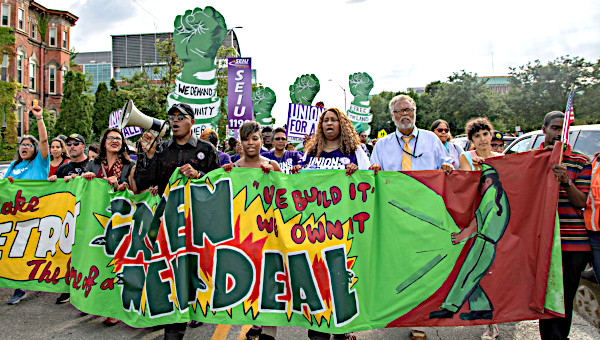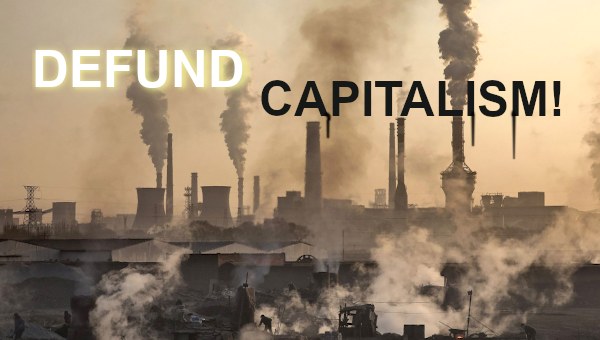Green New Deal: Plan, Mood, Battlefield
This article first published on the Viewpoint Magazine website.
Climate scientists are beginning to sound like radicals. The 2018 IPCC report concluded that “unprecedented changes across all aspects of society” would be needed to limit warming to 1.5 degrees Celsius. In its devastating report on the dire state of the planet’s ecosystems, the UN’s panel on Biodiversity and Ecosystem Services likewise called for, in the words of its chairperson, “fundamental, system-wide reorganization across technological, economic and social factors, including paradigms, goals and values.”
 The first, and thus far only, U.S. policy initiative that addresses the severity of the crisis before us is the Green New Deal (GND), introduced as a congressional joint resolution this past February. The resolution proposes, among other goals, decarbonizing the economy, investing in infrastructure, and creating dignified jobs for millions. And while this resolution is, from a planetary perspective, obviously limited by its domestic scale, transforming the U.S. along these lines would surely have global reverberations, for at least two reasons: the U.S. is a major impediment to global cooperation on climate, and political parties elsewhere in the world (e.g., the UK’s Labour Party and Spain’s Socialist Party) have already begun to adopt the Green New Deal as the frame for their own domestic policies.
The first, and thus far only, U.S. policy initiative that addresses the severity of the crisis before us is the Green New Deal (GND), introduced as a congressional joint resolution this past February. The resolution proposes, among other goals, decarbonizing the economy, investing in infrastructure, and creating dignified jobs for millions. And while this resolution is, from a planetary perspective, obviously limited by its domestic scale, transforming the U.S. along these lines would surely have global reverberations, for at least two reasons: the U.S. is a major impediment to global cooperation on climate, and political parties elsewhere in the world (e.g., the UK’s Labour Party and Spain’s Socialist Party) have already begun to adopt the Green New Deal as the frame for their own domestic policies.
After a few months of swirling discourse, we can begin to identify an emergent set of positions in the debate around the Green New Deal. The right-wing has resorted to classic red-baiting, decrying the nonbinding resolution as a “socialist monster,” a road to the serfdom of state planning, rationing, and compulsory veganism. The vanishing center is clinging tightly to its cozy attachment to a politics of triangulation: the Green New Deal is a childlike dream; serious adults know that the only option is to hew to the path of bipartisanship and incrementalism. The left, of course, knows that in the context of already-unfolding climate crisis, resurgent xenophobia, and the weakening hold on legitimacy of the neoliberal consensus, the real delusions are “market-driven” solutions and nostalgic paeans to American “norms and institutions.”
Same as the Old ‘New Deal’?
But on the left, too, there are criticisms, and outright rejections, of the Green New Deal (see here, here, here, and here). There is the charge that the Green New Deal, like the old New Deal, amounts to the state, qua executive committee of the bourgeoisie, rescuing capitalism from the planetary crisis it has created. In this rendering, rather than empowering “frontline and vulnerable” communities, as the resolution claims, the policy framework will amount to a corporate welfare windfall of investment opportunities lubricated with tax breaks and subsidies; public-private partnerships; infrastructure outlays that will stimulate real estate development; and, a jobs guarantee that will stimulate consumption – a win-win for the state and capital, but, by leaving the underlying, growth-addicted, model of accumulation untouched, a loss for the planet and the communities most vulnerable to climate crisis and eco-apartheid. There’s another twist. As sometimes the same analyses point out, this win-win-lose-lose scenario is itself based on a false understanding of contemporary capitalism. In a world of secular stagnation – declining profit rates, speculative bubbles, financialization, rentier-like behavior, and accumulation-by-upward-redistribution – the vampire-like quality of capital has never been more apparent. The notion that capital might, with a little inducement, suddenly overcome these tendencies and invest in productive activities is its own nostalgic fantasy.
For GND-skeptics on the left, this anachronistic green Keynesianism has its ideological counterpart in economic nationalism. The latter shows through in the resolution’s language positioning of the United States as an “international leader,” and in general a carbon accounting that stops at our borders, invisibilizing the vast global networks of extraction, production, and distribution that a massive transition to renewable energy would require. As Max Ajl put it, the political vision amounts to “green social democracy at home and militarized maritime and terrestrial borders, and beyond them, resource extraction for domestic clean-tech.” This could occur through, for example, neocolonial land grabs for renewable energy generation.
Relatedly, there are the extractive frontiers of the Green New Deal, obscured by a myopic focus on carbon accounting that begins and ends at the domestic electricity grid. A global, and holistic, view reveals that renewable energy will intensify mining, which provides the raw materials to remake our built environment to function exclusively on electricity. And a world of intensified mining is, in turn, one of accumulation by dispossession and contamination. One of these frontiers is lithium: mined from brine or from hard rock, it is a necessary component of the batteries that power electric vehicles or provide energy storage functions on renewable grids. In South America, lithium is extracted at alarming rates from the brine underneath the awe-inspiring salt flats that pepper a high-altitude plateau ringed by the Andean mountain range. The salt flats are vulnerable hydrological systems (of which the brine is an integral part), a kind of desert wetland that overlap with the territory, farmlands, and pastures of indigenous and mestizo peasant communities. In a 2050 scenario of 100% renewable transition with no alteration of current patterns of energy consumption, lithium demand would exceed 280% of known lithium reserves (i.e., the subset of deposits that are currently economically viable to extract).
Finally, there is the matter of the resolution’s total avoidance of the monster in the room: the fossil fuel industry, responsible for the vast majority of global emissions. This sector is an enormous domestic political obstacle: Due to the fracking boom, the U.S. is on track to be the top producer of oil and gas (indeed, the world is so awash in U.S. oil that major supply disruptions – “sanctions, strife and civil war” – now barely impact the price of crude). It is hard to imagine this monster voluntarily ceding its massive investments. In the eventuality of stringent emissions regulations and an enforced renewable transition, sunk outlays in drilling rigs, pipelines, and powerplants would become trillions of dollars of stranded assets (and trigger a global financial crisis) overnight.
These are real obstacles, real constraints, and real concerns. I argue, however, that a politics of pure negation – a politics that, in light of both the power of our enemies, and the limitations of the Green New Deal as currently conceived, positions itself primarily in opposition to the Green New Deal – is neither empirically sound nor politically strategic.
Decarbonizing
Let’s start with basic empirics. No one disputes that decarbonizing energy systems, nationally and globally, is desirable. The complex feedback mechanisms that shape the relationship between atmospheric warming and other forms of environmental devastation, from drought to sea-level rise to extreme weather events, are such that every degree – or tenth of a degree, for that matter – of warming avoided is a world that is orders of magnitude safer for human and nonhuman habitation, especially for those experiencing the dislocations of already-unfolding calamity (as I write, in the space of two months, the eastern coast of Africa was hit with two record-breaking cyclones; the first, Cyclone Idai, killed over a thousand people and affected millions more).
And no one disputes that decarbonization is technologically or even economically feasible. Renewable energy sector wonks and investors are gushing about the dramatic reductions in the costs of renewable energy and battery storage. There is the fraught question, of course, of how much land a primarily wind and solar energy system would require. There is no doubt that renewables are land-intensive, both in terms of generation (turbines and panels) and new transmission lines. But the estimates vary greatly. At the optimistic end, generating solar and wind power could use less than 1% of total U.S. landmass. On the pessimistic end, as Jasper Bernes states, they would occupy as much as 25-50 per cent – a rather wide range. However, even these percentages oversimplify the complexity. Unlike biomass and agriculture, a wind turbine and a farm are not mutually exclusive land-uses. Solar panels can go on rooftops, thus not all solar is in direct competition with land for growing food or for ecosystem restoration. Meanwhile, there are lots of land-uses that are ecocidal and anti-social, which could be swapped for renewable energy generation, or rewilded for natural carbon sequestration: manicured lawns, golf courses, parking lots, and the thousands of miles of federal land leased to oil and gas companies. And the possibilities for decarbonization can (and must) go beyond the power sector, including the infrastructure of global trade itself: for example, reducing the speed of container ships by 10% reduces almost 20% of their emissions.
As you might sense already, “technologically feasible” is a blanket term that papers over a world of distinct scenarios.
On one end of the spectrum, there is the already occurring energy transition, organized under the logic of green capitalism and the enormous “clean tech” industry. It pins its hopes on technical fixes like solar radiation management with the goal of altering as little of the prevailing model of accumulation as possible, leaving untouched how much energy is used, what it is used for, and who controls the energy system. At the other end of the spectrum would be decarbonization achieved through a mixture of 100% renewable energy, grid designs that maximize resiliency with distributed generation, ecosystem sequestration, energy efficiency, reduced energy demand (ensuring, of course, that reductions first and foremost target the wasteful over-consumption of the affluent), and a shift from a paradigm of privatized consumption toward one that values collective consumption governed by socially and ecologically sustainable resource use. This latter vision recognizes that the root causes of climate crisis – profit-seeking competition, endless growth, exploitation of humans and nature, and imperial expansion – can’t also be the solution to climate crisis.
Deciding between green capitalist and ecosocialist pathways to decarbonization – and the infinite gradations in between them – is politics. Politics not only in the United States, but all along the territorially-dispersed supply chain of the renewable transition, from extractive frontier to factory to container ship to warehouse to grid to home. In Chile, which provides 40 per cent of global lithium exports and where I have been conducting research, indigenous communities and environmentalists are beginning to organize against new lithium projects, in part through nascent alliances that traverse the Andean plateau to communities in Argentina and Bolivia.
At every node in this global chain, the technical and the political are intimately entangled. Declaring by fiat that decarbonization is unlikely or impossible amounts to an avoidance of the complex, historic, world-making tasks ahead of us.
Too Radical or Not Radical Enough?
The central ambivalence running through left critiques of the Green New Deal is whether it is too radical or, on the contrary, not radical enough (“mild reforms proposed by democratic socialists” in the words of Joshua Clover).
On the one hand, in order to achieve the economy-wide decarbonization it proposes, it would elicit a ruthless response of the ruling class (as Bernes warns, “you should expect the owners of that wealth to fight you with everything they have, which is more or less everything”). On the other hand, the Green New Deal saves capitalism from itself, and thus “leaves growth intact” (Bernes) as well as leaving intact “firms that are ruled by profit” (Clover). The political implications are equally ambivalent. On the first reading, the state, captured as it is by capital, would ensure that legislation never makes it out of committee, or is vetoed, or is watered down by the agencies tasked with its implementation and dies a slow, bureaucratic death. On the second reading, it’s hard to imagine why the political system would object to such mild reformism, especially given the tremendous legitimation effects to be gained from the appearance of taking serious action on climate.
Is the Green New Deal all-out class warfare or win-win green growth? Is it too radical to be thinkable let alone realizable in the current conjuncture or too reformist to meet the scale of the climate catastrophe?
One could of course argue, as I think Bernes in particular does, that this ambivalence inheres not in his critique of the Green New Deal, but in the policy vision itself, a vision that contains something for everyone, a mirror in which both the anti-capitalist and the venture capitalist can see their own desired future reflected.
There’s another reading of this indeterminacy, however. The state is not a unitary monolith; neither is capital. And these two facts are related. Capital is itself comprised of not only capitalists but entire sectors in competition with one other, competition being one of capitalism’s primary laws of motion. In addition to market share and investment, capitalists compete over the state: its policies, its largesse, its legitimating power. One can easily imagine some sectors favoring aspects of the Green New Deal (“clean tech”), with others working in lockstep against it (the fossil fuel industry). One could break this down further: some fossil fuel companies are investing billions in low and no carbon fuels; the real estate sector might resist costly energy-efficient retrofits but would stand to benefit from public investment in transportation infrastructure, which drives up adjacent property values. Understanding the stances of specific firms and distinct fractions of capital is a prerequisite for developing a strategic orientation that poses a credible threat to profit-making. And, even given the tremendous power of private investors to set the parameters of policymaking – a power that is particularly stark in our federal system, where cities and states compete for investment – this does not rule out the possibility that legislation might substantively change the rules of the game. Recently, in part due to ongoing pressure from a coalition of grassroots housing justice movements, New York City Council passed an impressively ambitious plan to limit emissions from buildings – despite the vocal protestations of the real estate lobby.
If state and capital are heterogenous, with competition between fractions of the ruling class at times providing strategic openings to exert popular power, the working class is also riven by difference and fragmentation. It is not a preconstituted agent, nor can we expect it to spontaneously unify at a moment of revolutionary rupture. There is no substitute for the slow and sometimes accelerated labour of composing working class interests. But, under the rubric of a “just transition,” the Green New Deal raises the possibility that workers in the very sectors that destroy the climate and ecosystems might form part of its coalition. Meanwhile, renewed strike activity among teachers – whose vital social reproduction labour would be a central part of a low-carbon society – invites us to expansively redefine what counts as a “green job” to encompass the often unvalued and invisibilized work of caring for each other and the planet.
“If state and capital are heterogenous, the working class is also riven by difference and fragmentation.”
More generally, it is precisely the indeterminacy of the Green New Deal that provides a historic opening for the left. Perhaps inadvertently, Bernes alludes to this potential: as he writes, for supporters of the Green New Deal, “its value is primarily rhetorical; it’s about shifting the discussion, gathering political will, and underscoring the urgency of the climate crisis. It’s more big mood more than grand plan.” I’ll have a bit more to say on the contrast between a “mood” and a “plan” below, but for now I want to pause and reiterate: “shifting the discussion, gathering political will, and underscoring the urgency of the climate crisis.” If, through the vehicle of the amorphous Green New Deal, left forces might achieve these three tasks, that strikes me as an exceedingly important development; not an end in and of itself, of course, but it’s unclear to me how a pathway to radical transformation wouldn’t pass through these three crucial tests of political capacity.
Demands or Deception?
In keeping with the charge of ambivalence is the charge of vagueness (Bernes: “The Green New Deal proposes to decarbonize most of the economy in ten years – great, but no one is talking about how.”). This is, on the face of it, not true. There is currently an efflorescence of proposals for how to decarbonize the economy, not only from the usual green capitalist policy wonks but also from agroecology enthusiasts, proponents of public banking and social housing, to those that tackle the logic of planned obsolescence and advocate for zero-waste production and consumption. I have never had so many conversations about the architecture of our electric grids, the relative contribution of distinct sectors to overall emissions, or the dilemmas of carbon taxes as I have had in the past few months. This is not to suggest that these myriad proposals will get the job done, nor to downplay the sharp contrasts between a proposal to expropriate the fossil fuel industry and a carbon price based on a high discount rate, but rather to state that many people are, in fact, talking about how to decarbonize. The battles over these distinct pathways will emerge as key political, and class, conflicts of our moment.
Bernes’ charge of vagueness, however, soon slides into a more serious accusation: deception. Socialists, like myself, that mobilize around the Green New Deal know full well that “the mitigation of climate change within a system of production and profit is impossible, but they think a project like the Green New Deal is what Leon Trotsky called a ‘transitional program’, hinged upon a ‘transitional demand’.” For such socialists, he argues, it is precisely the combination of technological feasibility and systemic impossibility that makes the Green New Deal a radicalizing demand: if capitalism could, but won’t, save humanity and the planet, then the masses will rise up against the true obstacle to progress. Not only is this strategy fundamentally patronizing and deceptive, as he points out, but it is self-defeating: “the transitional demand encourages you to build institutions and organizations around one set of goals” and then convert them to another. In this case, organizations designed to “[solve] climate change within capitalism” and, when that fails, are expected to “expropriate the capitalist class and reorganize the state along socialist lines.” Institutions, however, “are tremendously inertial structures” – once designed for one purpose, they can’t be transformed.
 This strikes me as a very odd statement. In the social sciences, “path dependency” is more or less the mantra of mainstream institutional theory and functions ideologically to encourage resignation to the status quo. A historically-grounded, critical view of institutions sees them always as live, provisional, crystallizations or resolutions to class conflict, in need of ongoing reproduction and legitimation. They are the social arrangements through which violent domination is transmogrified into hegemony.
This strikes me as a very odd statement. In the social sciences, “path dependency” is more or less the mantra of mainstream institutional theory and functions ideologically to encourage resignation to the status quo. A historically-grounded, critical view of institutions sees them always as live, provisional, crystallizations or resolutions to class conflict, in need of ongoing reproduction and legitimation. They are the social arrangements through which violent domination is transmogrified into hegemony.
This is a lesson the right knows very well, displayed in its maneuvers into every nook and cranny of institutional life: school boards, state governments, local courts, utility commissions. Elsewhere, from the Communist Party in Kerala, India, to the radical municipalism movement in Spain, left parties and movements have experimented with institutional change. Through a mix of policy innovation, trial and error learning, and social organization, they have chipped away at exclusion and domination. Kerala, incidentally, mobilized local institutions and networks of solidarity in an impressive response to the massive floods in the summer of 2018 – an example with clear implications for the increasingly stormy conditions ahead of us.
Beyond Ambient Despair and Cruel Optimism
It turns out, however, that advocates of the Green New Deal are not just deceptive but themselves duped. In their fever dreams of rosy futures, “The world of the Green New Deal is this world but better – this world but with zero emissions, universal health care, and free college.” For these green dreamers, reality will be a rude awakening: “The appeal is obvious but the combination impossible. We can’t remain in this world.” Nothing short of “completely reorganiz[ing] society” will do the trick.
It’s not only the Green New Dealers who have dreams. Bernes too conjures “an emancipated society, in which no one can force another into work for reasons of property, could offer joy, meaning, freedom, satisfaction, and even a sort of abundance.” This is quite close to my own radical horizon. But how do we get there? “We need a revolution.” Seriousness, however, swiftly returns: “a revolution is not on the horizon.” This sober appraisal accords with the overall tone of the essay. He is merely stating the facts; telling the truth instead of lying (“Let’s instead say what we know to be true”; “But let’s not lie to each other”; or, for Clover, “Now we have arrived at serious matters”). These exhortations figure the author as above the fray, cool, and objective and his targets as confused, deceptive, duped, and, to return to the aforementioned quote, seduced by the Big Mood of the green dream. But isn’t the “ambient despair” that Bernes describes as the inevitable affective register of his reality check a mood, too?
Curiously, some of the left negations of the Green New Deal resonate with the dismissals of our shared conservative enemies: both adopt a register of self-conscious seriousness and paint the policy as a fantasy or, worse, as a malicious plan disguised as a better world. While the right tends to fixate on the affordability of the public investments required, Bernes asserts its objective unfeasibility (“Implementation is where it really dies”). Paradoxically, in making claims on the basis of an appeal to objective viability, left skeptics miss out on the opportunity to make a more convincing argument. Contra Bernes, the greatest obstacle to the Green New Deal is not “implementation” but politics. A properly political critique would contend that the Green New Deal sustains the fantasy that an enlightened state can save us from climate catastrophe, a fantasy that discourages us from taking the radical actions that are, in fact, a prerequisite for the state doing anything at all. And the temptation of demobilization, of projecting our collective capacities in alienated form onto the state, might be all the more seductive in the eventuality of a Democratic victory in 2020. The Green New Deal, on this account, would be a textbook case of cruel optimism: the sense of hope it inspires is exactly what undermines its actualization.
Pessimism certainly protects us from the psychic pain of disappointment. Yet, the risk of pessimism is that it tends to shade into fatalism, which has the same demobilizing dynamic as the fantasy of state salvation. There is, however, another option. The opposite of pessimism isn’t self-assured optimism, but rather militant commitment to collective action in the face of uncertainty and danger. We might take our cue from social movements that adopt a stance of critical support, embracing the political opening afforded by the Green New Deal while at the same time contesting some of its specific elements, thus pushing up against and expanding the horizon of political possibility. Indigenous and environmental justice movements have issued detailed statements that support some aspects of the resolution and not others (especially the language of “clean” and “net zero” energy, which opens the door to untested geoengineering technologies and carbon offset schemes), and consistently prioritizing the demands of the excluded, exploited, and dispossessed over and against technocratic approaches to policymaking. The Democratic Socialists of America’s (DSA) Ecosocialist Working Group (disclaimer: I serve on the Steering Committee) developed a set of principles that support the resolution while substantively exceeding its content, framing “the fight for the climate as a struggle against capitalism itself and the myriad forms of oppression which sustain it.” In a similar vein, Kali Akuno of Cooperation Jackson has critiqued the productivism and nationalism of the Green New Deal framework, while advocating for both the development of grassroots alternatives (such as cooperatives, urban farming, ecosystem restoration) and mass civil disobedience to fight for a radical, just transition to ecosocialism.
“The opposite of pessimism isn’t self-assured optimism, but rather militant commitment to collective action in the face of uncertainty and danger.”
Rather than taking refuge in negation, these movements grapple head-on with a complex strategic dilemma: the challenge of simultaneously confronting the fractions of capital and their many allies in the state who will fight most ruthlessly to preserve fossil capital and radicalizing the politics of the Green New Deal beyond its current limitations.
How the new world is born out of the old is of course the vexed question of any project of radical transformation. What kinds of programmatic demands, organizational forms, and institutional designs can be proposed, mobilized, and assembled under present conditions but that would, once set into motion, violate the sanctity of growth, property or profit? What tactics of disruption are available to us? What nascent coalitions might weave solidarities across the dispersed supply chains of the energy transition? What financial crises might be on the horizon? What fractions of capital ascendant or descendent? Where are the vulnerabilities in the hegemonic order?
We are living in a moment of profound turbulence; predicting or foreclosing the future seems less analytically rigorous than actively intervening to shape it. We don’t yet know how the politics of the Green New Deal will play out. We can be certain, however, that resignation cloaked in realism is the best way to ensure the least transformative outcome. Waiting for ever-deferred moment of revolutionary rupture is functionally tantamount to quiescence. In an extremely asymmetric conflict against fossil fuel executives, private utilities, landlords, bosses and the politicians that do their bidding, we need both extra-parliamentary, disruptive action from below – taking inspiration from Standing Rock, the teachers’ strike wave, Extinction Rebellion, the global youth climate strikes – and creative experimentation with policies and institutions. The battles to come have the potential to unleash desires and transform identities. We will learn, screw up, and learn again. The Green New Deal doesn’t offer a prepackaged solution, it opens up a new terrain of politics. Let’s seize it. •





